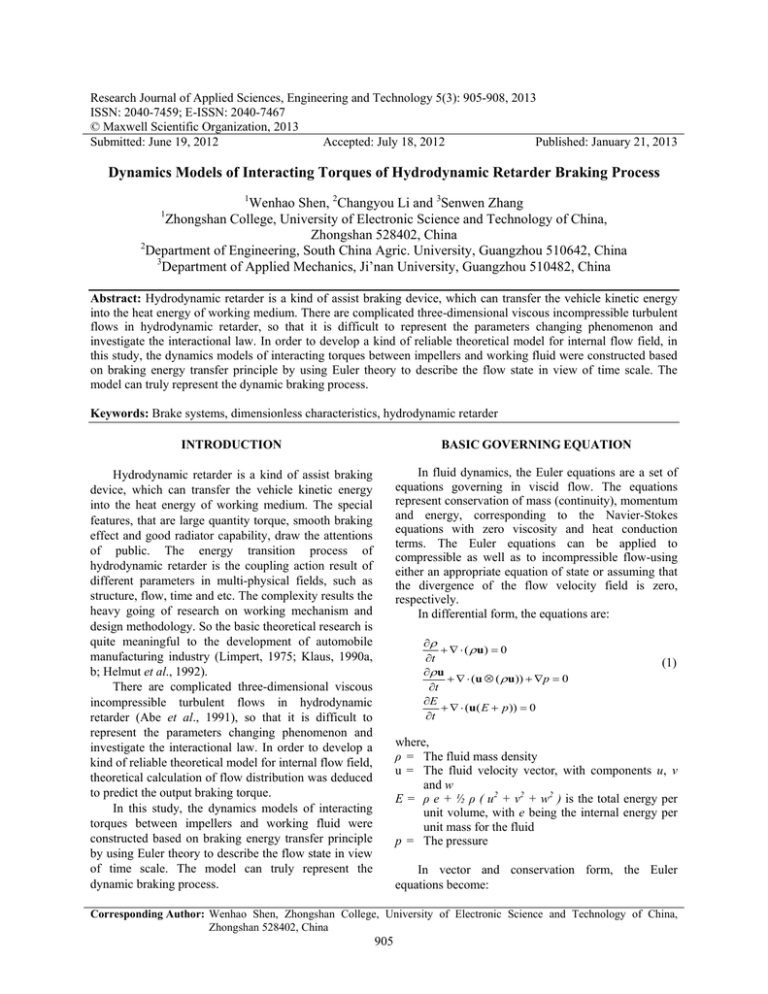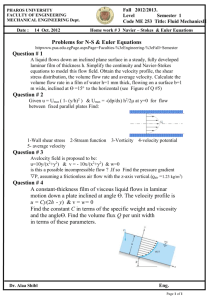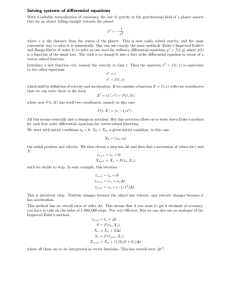Research Journal of Applied Sciences, Engineering and Technology 5(3): 905-908,... ISSN: 2040-7459; E-ISSN: 2040-7467
advertisement

Research Journal of Applied Sciences, Engineering and Technology 5(3): 905-908, 2013 ISSN: 2040-7459; E-ISSN: 2040-7467 © Maxwell Scientific Organization, 2013 Submitted: June 19, 2012 Accepted: July 18, 2012 Published: January 21, 2013 Dynamics Models of Interacting Torques of Hydrodynamic Retarder Braking Process 1 Wenhao Shen, 2Changyou Li and 3Senwen Zhang Zhongshan College, University of Electronic Science and Technology of China, Zhongshan 528402, China 2 Department of Engineering, South China Agric. University, Guangzhou 510642, China 3 Department of Applied Mechanics, Ji’nan University, Guangzhou 510482, China 1 Abstract: Hydrodynamic retarder is a kind of assist braking device, which can transfer the vehicle kinetic energy into the heat energy of working medium. There are complicated three-dimensional viscous incompressible turbulent flows in hydrodynamic retarder, so that it is difficult to represent the parameters changing phenomenon and investigate the interactional law. In order to develop a kind of reliable theoretical model for internal flow field, in this study, the dynamics models of interacting torques between impellers and working fluid were constructed based on braking energy transfer principle by using Euler theory to describe the flow state in view of time scale. The model can truly represent the dynamic braking process. Keywords: Brake systems, dimensionless characteristics, hydrodynamic retarder INTRODUCTION BASIC GOVERNING EQUATION Hydrodynamic retarder is a kind of assist braking device, which can transfer the vehicle kinetic energy into the heat energy of working medium. The special features, that are large quantity torque, smooth braking effect and good radiator capability, draw the attentions of public. The energy transition process of hydrodynamic retarder is the coupling action result of different parameters in multi-physical fields, such as structure, flow, time and etc. The complexity results the heavy going of research on working mechanism and design methodology. So the basic theoretical research is quite meaningful to the development of automobile manufacturing industry (Limpert, 1975; Klaus, 1990a, b; Helmut et al., 1992). There are complicated three-dimensional viscous incompressible turbulent flows in hydrodynamic retarder (Abe et al., 1991), so that it is difficult to represent the parameters changing phenomenon and investigate the interactional law. In order to develop a kind of reliable theoretical model for internal flow field, theoretical calculation of flow distribution was deduced to predict the output braking torque. In this study, the dynamics models of interacting torques between impellers and working fluid were constructed based on braking energy transfer principle by using Euler theory to describe the flow state in view of time scale. The model can truly represent the dynamic braking process. In fluid dynamics, the Euler equations are a set of equations governing in viscid flow. The equations represent conservation of mass (continuity), momentum and energy, corresponding to the Navier-Stokes equations with zero viscosity and heat conduction terms. The Euler equations can be applied to compressible as well as to incompressible flow-using either an appropriate equation of state or assuming that the divergence of the flow velocity field is zero, respectively. In differential form, the equations are: ∂ρ + ∇ ⋅ ( ρ u) = 0 ∂t ∂ρ u + ∇ ⋅ (u ⊗ ( ρ u)) + ∇p = 0 ∂t ∂E + ∇ ⋅ (u( E + p )) = 0 ∂t (1) where, ρ = The fluid mass density u = The fluid velocity vector, with components u, v and w E = ρ e + ½ ρ ( u2 + v2 + w2 ) is the total energy per unit volume, with e being the internal energy per unit mass for the fluid p = The pressure In vector and conservation form, the Euler equations become: Corresponding Author: Wenhao Shen, Zhongshan College, University of Electronic Science and Technology of China, Zhongshan 528402, China 905 Res. J. Appl. Sci. Eng. Technol., 5(3): 905-908, 2013 ∂m ∂f x ∂f y ∂f z 0 + + + = ∂t ∂x ∂y ∂z Rotator Stator (2) Central Stream Surface o r where, i Spin Axis O′ O Fig. 1: Flow passage on axial plane of hydrodynamics retarder (circulating circle) vmo vmi i R o R ρv ρ uv f y = p + ρv2 ; ρ uw v( E + p) ρ w ρ uw f z = ρ vw 2 p + ρw w( E + p ) r ρ ρu m = ρv ; ρw E ρu 2 p + ρu f x = ρ uv ; ρ uw u ( E + p) O′ O (3) Fig. 2: Velocity projection on axial plane of blade vo wo βo uo wi vi Ro ui Ri and f x , f y , f z are all fluxes. DESCRIPTION IN EULER EQUATION FOR ONE SPATIAL DIMENSION βi O′ O Fig. 3: Projection of blade middle rotating face on axial direction For certain problems, especially when used to analyze compressible flow in a duct or in case the flow is cylindrically or spherically symmetric, the onedimensional Euler equations are a useful first approximation. Generally, the Euler equations are solved by Riemann's method of characteristics. This involves finding curves in plane of independent variables along which partial differential equations degenerate into ordinary differential equations. Numerical solutions of the Euler equations rely heavily on the method of characteristics. Following the Euler One Spatial Dimension Assumption, the flow can be described in circulating circle as Fig. 1. For every flow particle, its velocity can be projected on Axial Plane of Blade passing through as Fig. 2. In order to show the relationship of velocity vectors in the inlet and outlet of blade, the axial projection plane was draw for the central stream v v m vu w β u Fig. 4: Velocity triangle of fluid particle surface. In Fig. 3, the velocity vector triangles were formatted at different positions in the inlet and outlet. In analysis, the absolute velocity was expressed in two orthogonal sub-vectors with v m and v u : v = vm + vu (4) where, v m : Meridional component of velocity, which is tangent to the flow line in axial plane v u : Peripheral component of velocity 906 Res. J. Appl. Sci. Eng. Technol., 5(3): 905-908, 2013 In the Velocity Triangle of Fluid Particle that was showed in Fig. 4, the absolute velocity, relative velocity, following velocity, meridional component of velocity and peripheral component of velocity were described to express the relationship with each other. The following velocity of each Fluid Particle on central surface of revolution between blades can be denoted as following and the meridional component of velocity is the same: u r= ω = 2π Rn 60 Q vm = Am r O A τ X Z Fig. 5: Control body in flow field ∑F×r − ∫∫ ρ (nv)(r × v)dA (5) A = (6) (8) ∂ r × ρ vdτ ∂t ∫∫∫ τ For hydrodynamic retarder, by taking the working medium particle as control body, the formula was turned to calculate the torque between impeller and liquid: T= ∂ r × ρ vdV + ∫∫ ρ (nv)r × vdA ∂t ∫∫∫ A V (9) where, r = Position vector of fluid particle unit element (m) v = Velocity vector of fluid particle unit element (m/s) dV = Volume of fluid particle unit element (m3) dA = Superficial area of fluid particle unit element (m2) V = Volume of control body (m3) A = Superficial area of control body (m2) ρ = Fluid mass density (kg/m3) So, it’s deduced as: = u + vm ctg β dτ dA where, r = The radius of fluid particle to the revolution axis (m) ω = Rotation angular speed of blade (rad/s) n = Rotation speed of blade (r/min) Q = Circulating flux through blade flow passage (m3/s) A m = The cross-sectional area of flow passage tangent to meridional component of velocity (m2) vu = u − vm ctg (π − β ) mv Y (7) = ω r + vm ctg β DYNAMIC TORQUE MODEL The algebra representation of the above vector representation can be deduced as: In order to control the brake torque of hydrodynamic retarder accurately, it’s necessary to o ∂ build a practical mathematical model to describe the = T ∫ ( r ρ vu ) Am dr + ( ρ o vuo vmo ro Amo ∂ t i real working situation of hydrodynamic retarder. The − ρi vui vmi ri Ami ) most existing models are all static models which just considered the relationship of brake torque with o rotation speed or effective diameter of circulating circle ∂ = ∫ [ r ρ (ω r + vm ctg β )] Am dr (Abe et al., 1991; Klaus and Flack, 1996; Joel, 2002; ∂ t i Lasse, 2002), so they were not overall enough to reflect +[ ρ o (ω ro + vmo ctg β o )vmo ro Amo the all different factors influencing the brake − ρi (ω ri + vmi ctg β i )vmi ri Ami ] performance, moreover they could not provide the effective feedback quantity to accuracy control. A kind o of practical dynamic mathematical model was developed in following. Take a fluid unit element as= ρ ∫ [r (ω ′r + vm′ ctg β )] Am dr i control body showed in Fig. 5. (10) +[ ρ o (ω ro + vmo ctg β o )vmo ro Amo The theorem of moment of momentum for − ρi (ω ri + vmi ctg β i )vmi ri Ami ] hydromechanics can be expressed as follows. And then the forces on the control body can be calculated by Because of the flow consecutiveness of fluid in resolving the change rate of moment of momentum, canned pipe, the properties can be expressed as: rather than integrating the stress distribution: 907 Res. J. Appl. Sci. Eng. Technol., 5(3): 905-908, 2013 v= v= vm , mi mo CONCLUSION (11) = A A= Am , mi mo In order to control the brake torque of hydrodynamic retarder accurately, it’s necessary to build a practical mathematical model to describe the real working situation of hydrodynamic retarder, especially the short-term oil feeding and oil draining process. The most existing models are not suitable enough to reflect the all different factors influencing the brake performance. Based on the theorem of moment of momentum for hydromechanics, a kind of practical dynamic mathematical model was developed. The deduced equations are more objective to reflect the true situation occurring in the internal space of impellers. And it can provide reference for the structure and control design. ρ= ρ= ρ i o And then the formula can be simplified as: o = T ρ Am ∫ (ω ′r + vm′ ctg β )rdr i (12) + ρ Am vm [(ω ro + vm ctg β o ) ro −(ω ri + vm ctg β i ) ri ] In this formula, the impeller torque consists of two parts and the integration part ρ A o (ω ′r + v′ ctg β )rdr m ∫ m i indicates the unsteady state factor. When the hydrodynamic retarder drives to the steady state, ω ′ = 0 and vm′ = 0 , the integration unsteady state factor part turns to 0. So the steady state torque can be expressed without the integration unsteady state factor part: ACKNOWLEDGMENT Study partially supported by grant of Research Start-up Fund of Zhongshan College, UESTC; China 863 Program (2006AA10Z262); Research Fund for the Doctoral Program of Higher Education of China (20060564003); National Agricultural Foundation for Transformation of Scientific and Technological Achievements (2006E00100286). = T ρ Am vm [(ω ro + vm ctg β o )ro (13) −(ω ri + vm ctg β i )ri ] And this formula is equivalent with the existing ones. For the torque between rotator and liquid, the formula is: REFERENCES Abe, K, T. Kondoh, K. Fukumura and M. Kojima, 1991. Three-Dimensional Simulation of the Flow in a Torque Converter. SAE, 910800, pp: 36-41. Helmut, S., K. Heinz and R. Bernhard, 1992. ZF Retarder in Commercial Vehicles. Society of Automotive Engineers, Warrendale, Pa, pp: 11. Joel, R., 2002. Anstrom. In: Model development for hybrid electric vehicle stability assists systems. Ph.D. Thesis, Pennsyivania State University, In Press. Klaus, V., 1990a. Hydrodynamics Retarder. U.S. Patent 624620. Klaus, V., 1990b. Hydrodynamics Retarder with Shiftable Stator Blade Wheel. U.S. Patent 681185. Klaus, B. and R.D. Flack, 1996. The Flow Field inside an Automotive Torque Converter, Laser Velocimeter Measurements. SAE Technical Paper 960721, pp: 98-106. Lasse, M., 2002. Modeling and longitudinal control of commercial heavy vehicle equipped with variable compression braking. Ph.D. Thesis, University of California Santa Barbara, In Press. Limpert, R., 1975. Rudolph. Investigation of Integrated Retarder/Foundation Brake Systems for Commercial Vehicles. Society of Automotive Engineers, Warrendale, PA, pp: 8. o = TR − F ρ Am ∫ (ωR′ r + vm′ ctg β )rdr i + ρ Am vm [(ωR rRo + vm ctg β Ro )rRo (14) − (ωR rRi + vm ctg β Ri )rRi ] For the torque between stator and liquid, the formula is: o = TS − F ρ Am ∫ (ωS′ r + vm′ ctg β )rdr i + ρ Am vm [(ωS rSo + vm ctg β So )rSo (15) − (ωS rSi + vm ctg β Si )rSi ] In Eq. (14) and (15), the integration unsteady state factor parts are meaningful to the real braking process of hydrodynamic retarder. In the short-term oil feeding and oil draining process, the output torque of hydrodynamic retarder is unsteady, so the two equations are more objective to reflect the true situation occurring in the internal space of impellers. And the equations are universal by consisting of the integration unsteady state factor part. The unsteady output torque calculation can provide reference for the structure and control design. 908







